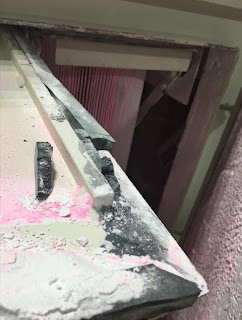We were called in to do a leak test on a cartridge collector. It had visible dust emission just out of the stack.
With the system running, fluorescent powder was added to the dirty side of the cartridge filter. The collector was then shut down, and access doors were opened. Broken gasket seals (Figure 3 & 4) and one leaking cartridge with the help of black light (Figure 5) clearly came into view.
 |
| Figure 1 Dirty side of the collector |
 |
| Figure 2 Dirty side of the collector |
 |
| Figure 3 Broken and shrunk gasket |
 |
| Figure 5 Leak detected in a cartridge with the help of a black light |
After the leaky cartridge and the broken gaskets were replaced, the cartridge collector worked normally again.
Later, a dust detector paired with a tower light alarm was installed on the ductwork behind the dust collector.
Any regular maintenance program for your baghouse/cartridge collector should include periodic Leak testing. This maintenance task helps to detect compromised filters, expose bag bleed-through, damaged tubesheets, or bad seals within your system that can lead to dust emission.
Leak Test, Air Balancing, Trouble-shooting, and System Evaluation services by Airvate
- Dye test for bag/cartridge leak
- Dust collection system and industrial ventilation system testing and Air Balancing
- Technical services: field survey and dust collection system evaluation and trouble-shooting
- New system start-up
- Dust sample analysis
- Dust collector selection and sizing: baghouse, wet scrubber, cyclone, settling chamber, drop-out box, etc.


Comments
Post a Comment
Feel Free To Leave Your Comment Below!